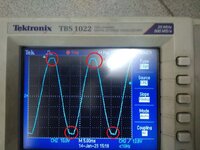prakashvenugopal
Advanced Member level 1





Hi,Hi,
Clearly a core saturation effect.(as long as you did not connect anything at the secondary... like a rectifier)
--> just reduce the primary voltage.
It seems the transfomer has several primary input options. But you did not say which one you used.
--> Use the 240V one.
Klaus
1) read post#2Kindly let us know how to avoid this Flat topping in the Transformer Secondary Waveform.
Hi,Hi,
1) read post#2
2) remove the bride rectifier
Klaus
Hi,It isn't a problem and it wont stop it working. What is happening is the load current is causing a voltage drop. This is normal and the only way to reduce it is to use a larger transformer. I suspect you have a reservoir capacitor after the bridge rectifier and also some DC load on it. As the load current drops the capacitor voltage and the transformer voltage starts to exceed it, current is drawn to recharge the capacitor. This is why the current is only at peaks of the AC cycle. As the current is drawn from the transformer, the resistive and magnetic losses cause a voltage drop and hence the flat topping of the waveform.
Brian.
It is NOT POSSIBLE to completely remove your observed flat-top, only to reduce it. As Betwixt pointed out, this voltage droop is caused by IR drop of internal resistance of transformer. It will ONLY dissappear if you have NO LOAD.Hi,
Thanks for the reply.
1. I had Converted this secondary Tx AC Voltage --> Bridge rectifier --> LM 317 regulator --> +18V DC
without the bridge rectifier, i cant generate +18V DC.
In this case, How to remove the bridge rectifier.
2. If i use the Primary Transformer tapping 0-240V ac, this will solve the flat topping?
Regards,
V. Prakash
--- Updated ---
Hi,
Thanks for the reply.
Larger transformer in the sense?
Existing transformer design:
Primary : 0-200-220-240V / 2A
Secondary1 : 24-22-20-0-20-22-24V / 72VA
Secondary2: 0-16.5 / 16.5VA
How much Transformer VA can be increased to avoid this flat topping?
Regards,
V. Prakash
Hi,Hi,
Asking the same question again will not bring any new information. Why not simply try what was recommendend, then you immediately get the result.
******
* in post#1 you did not mention any load.
Without load, the most probable reason for flat top is core saturation.
(although it rather is expected to happen "after" the top.)
You may reduce core saturation with using the 240V tap or reducing the input voltage
* now you say you have a load, that draws "nonlinear" current. (how could we know before?)
So - if you want to reduce the flat top - you have to remove the "nonlinear load".
It could be so simple: just do what we recommended and see what happens.
If you neither want to do the one nor the other recommendation ... then a discussion is useless.
Klaus
I'll ask again.Can you please explain how to remove the non-linear load?
Disconnect.Can you please explain how to remove the non-linear load?
Hi,Disconnect.
At least for a test.
Hi,Hi,
Again, Again: What´s the problem with the flat top?
Why don´t you answer this question?
We are now at post#15 .....
******
How to remove flat top with load connected?
--> My idea is to use some kind of "PFC" stage at the secondary.
Klaus
Hi,Core saturation happens - in case - at Vdtmax rather than Vmax.
Slightly distorted waveform with flattened top is often observed already at the mains terminals. At transformer secondary it's by rectifier load with filter capacitor.
Distorted input current and flattened output voltage are both caused by rectifier filter capacitor and are unevitable with this power supply circuit topology.Non-linear power supplies draw current in high-amplitude short pulses that create significant distortion in the electrical current and voltage wave shape—harmonic distortion, measured as total harmonic distortion (THD)
Those harmonics have nothing to do with the quality of the DC out of the regulator.Please refer the link of Flat-topping relates to the Power quality and the harmonics:
How is it making you system malfunction?THD of Transformer Secondary shows high when comparing to Transformer Primary and also making my system malfunction.
We use cookies and similar technologies for the following purposes:
Do you accept cookies and these technologies?
We use cookies and similar technologies for the following purposes:
Do you accept cookies and these technologies?
